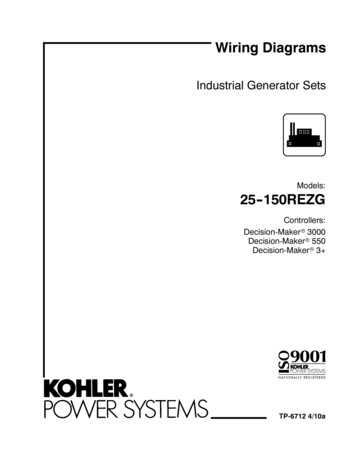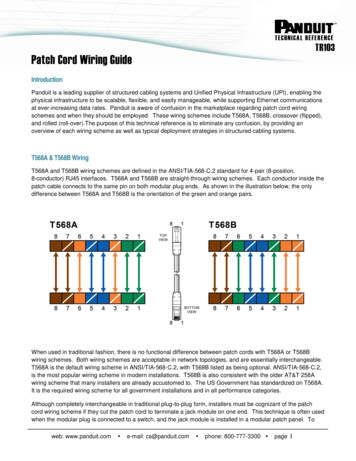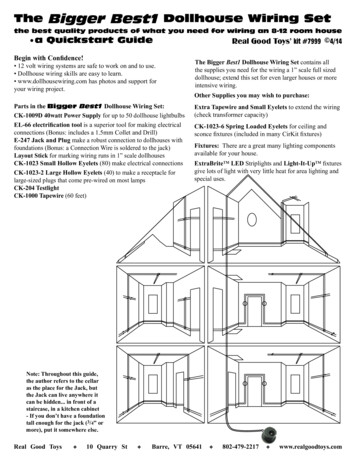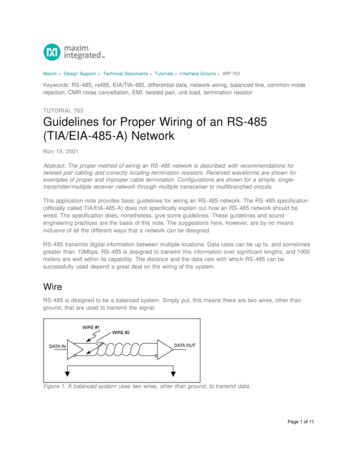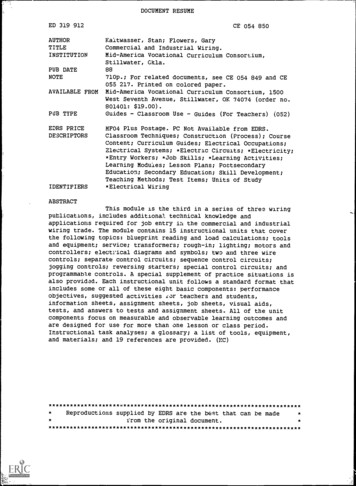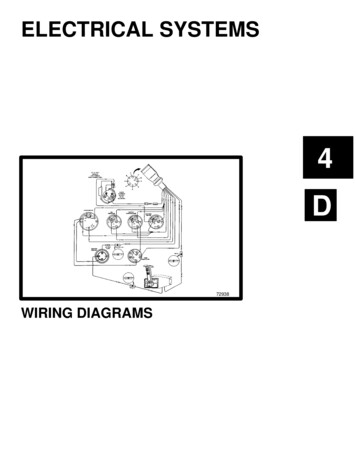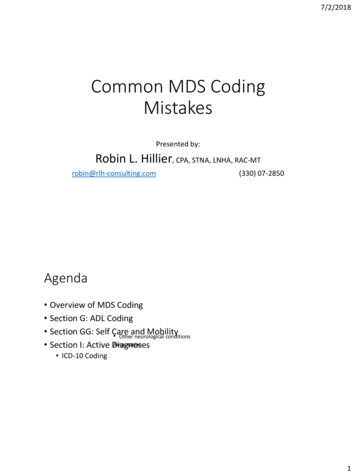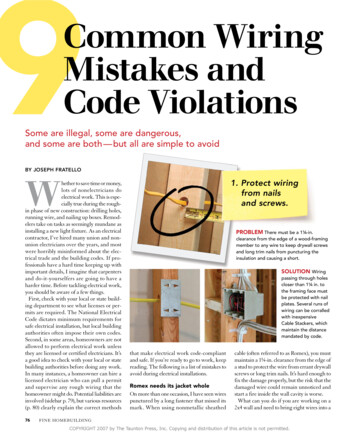
Transcription
9Common WiringMistakes andCode ViolationsSome are illegal, some are dangerous,and some are both — but all are simple to avoidBY JOSEPH FRATELLOWhether to save time or money,lots of nonelectricians doelectrical work. This is especially true during the roughin phase of new construction: drilling holes,running wire, and nailing up boxes. Remodelers take on tasks as seemingly mundane asinstalling a new light fixture. As an electricalcontractor, I’ve hired many union and nonunion electricians over the years, and mostwere horribly misinformed about the electrical trade and the building codes. If professionals have a hard time keeping up withimportant details, I imagine that carpentersand do-it-yourselfers are going to have aharder time. Before tackling electrical work,you should be aware of a few things.First, check with your local or state building department to see what licenses or permits are required. The National ElectricalCode dictates minimum requirements forsafe electrical installation, but local buildingauthorities often impose their own codes.Second, in some areas, homeowners are notallowed to perform electrical work unlessthey are licensed or certified electricians. It’sa good idea to check with your local or statebuilding authorities before doing any work.In many instances, a homeowner can hire alicensed electrician who can pull a permitand supervise any rough wiring that thehomeowner might do. Potential liabilities areinvolved (sidebar p. 79), but various resources(p. 80) clearly explain the correct methods761. Protect wiringfrom nailsand screws.PROBLEM There must be a 11 4-in.clearance from the edge of a wood-framingmember to any wire to keep drywall screwsand long trim nails from puncturing theinsulation and causing a short.SOLUTION Wiringpassing through holescloser than 11 4 in. tothe framing face mustbe protected with nailplates. Several runs ofwiring can be corralledwith inexpensiveCable Stackers, whichmaintain the distancemandated by code.that make electrical work code-compliantand safe. If you’re ready to go to work, keepreading. The following is a list of mistakes toavoid during electrical installations.Romex needs its jacket wholeOn more than one occasion, I have seen wirespunctured by a long fastener that missed itsmark. When using nonmetallic sheathedcable (often referred to as Romex), you mustmaintain a 11 4-in. clearance from the edge ofa stud to protect the wire from errant drywallscrews or long trim nails. It’s hard enough tofix the damage properly, but the risk that thedamaged wire could remain unnoticed andstart a fire inside the wall cavity is worse.What can you do if you are working on a2x4 wall and need to bring eight wires into aFINE HOMEBUILDINGCOPYRIGHT 2007 by The Taunton Press, Inc. Copying and distribution of this article is not permitted.
box? Cable Stackers, a 3M product (www.3m.com), hold up to eight wires andmake it easy to position them correctly.In some circumstances, you have nochoice but to bore a hole closer than 11 4 in.from a framing edge. There, you must installa steel nail plate, either 1 16 in. thick or ULlisted for that purpose, to protect the wiresfrom damage.2. Don’t mix linevoltage and lowvoltage wires.PROBLEM Parallel runs of line- and lowvoltage wires cause interference in electronicsand/or communication, such as TVs andtelephones. Also, any uninsulated contactbetween low- and line-voltage wires in a boxcan damage equipment or cause a fire.Keep low and line voltage apartI often see two-gang boxes installed witha cable or phone jack in one half and a 120voutlet in the other. If an exposed conductorof a low-voltage wire comes in contact with120v, the higher voltage can damage whatever is at the end of the low-voltage wire.A solid connection between the exposedlow-voltage wire and a 120v wire also cancause the insulation to melt and start a fire.You can’t run communication wires (phone,cable, or other low-voltage wires) into abox occupied by 120v or higher unless thecommunication wire or the box is rated forthat use.A similar situation concerns proximity.Phones, cable boxes, computers, and televisions all are susceptible to interference, acondition made worse when line voltageand low voltage are run parallel through thesame hole. The extent of the interferencedepends on the quality of wire you use andthe amount of current passing through theline-voltage wires. When I run low-voltagewires parallel to line-voltage wires, I fastenthe low-voltage wires at least 6 in. away fromthe line voltage.When you run line- and low-voltage wiresin the same hole, you risk having theline voltage cross over into the low voltage, which can also cause a fire. Oneunfortunate incident I witnessed couldhave been easily avoided by keepingthe wires separated.A carpenter was adding extra bracing for floor joists in the basementof a house we had wired. As he wasnailing, he didn’t look to see whatwas on the other side of the joist. Hedrove a 16d nail straight througha 120v electrical line and into athermostat wire that the HVACcontractor had run through thesame hole after the rough wiringwas complete. When the 120v crossed intothe thermostat wire, it destroyed the entirehome-automation system, along with all theSOLUTION Maintain aminimum of 6 in. betweenparallel runs, and you won’thave to shout over the phone.Don’t bring low voltageand line voltage together inthe same box. Instead, useseparate boxes or a box thathas an approved divider.control boards for the heating and air conditioning. Although many people blamed thecarpenter for the mishap, the HVAC contractor had violated the code and was responsiblefor the damage. The HVAC mechanic whoran the wire lost his job.Overcrowded boxes can start a fireWhen too many wires, outlets, or switchesare crammed into a box, the heat generateddoesn’t have enough airspace to dissipate andin turn can melt wire insulation and has thepotential to cause a fire.The problem is made worse when you adddimmers to a crowded switch box. Dimmers generate a substantial amount of heaton their own; combined with the heat potential of the wires, a bad situation can be madeworse. I’ve never seen a box catch fire as aresult of being overfilled with wires, but Ihave seen a few melted dimmers. The nexttime you try to cram eight wires into a singlegang box, think about who would be responsible if the box caught fire.The easiest way to learn how to calculatethe maximum wire fill of any box is to use3. Don’t stuff toomany wiresinto a switch oroutlet box.www.finehomebuilding.comCOPYRIGHT 2007 by The Taunton Press, Inc. Copying and distribution of this article is not permitted.PROBLEMOvercrowdedboxes canoverheat, causeinsulation to melt,and potentiallycause a fire.SOLUTION Ifthe box is toosmall, use a largerbox and a plateknown as a plaster(or mud) ring.77
4. Use a splice boxwhen installinga new fixtureto old wire.the NEC Handbook, which has a sectiondedicated to this subject; you also can read“More Wires Need Bigger Boxes” (FHB#144 or FineHomebuilding.com).Read labels before installing newlight fixtures to old wiresThe last time you put up a new light fixture,did you notice the little tag on the fixture thatsays, “If your house was built prior to 1987PROBLEM Because ofSOLUTION A splice box and a minimumcompatibility issues related tosafe operating temperatures, newfixtures can overload an olderwiring system and cause a fire ifimproperly installed.of 3 ft. of new wiring should connect a newlight fixture to a circuit wired before 1987.It’s the preferable alternative to rewiringthe entire circuit. Here’s a good way todetermine the wiring’s age: Insulationjackets made after 1987 are stamped withthe date of manufacture (inset photo right);those made prior to 1987 have no date.or has 60 C wiring, consult a qualified electrician”? Wire is rated for the safe operatingtemperature of the conductors. Newer lightfixtures are made with 90 C wires, whichmeans the wire inside the fixture is rated tooperate safely at temperatures up to 90 C.Problems occur when you connect the newfixture to old wires in the house. Most homesbuilt before 1987 were wired with 60 C conductors; the new fixture can create heat thatcan overpower the older wires’ capacity andpossibly cause a fire.A couple of solutions exist. The first optionis to replace the old wire from the switchto the light with new wire. Unless you arerenovating, however, that’s not very attractive. The second option is far more common.If there is access above the light (in an attic5. Don’t usewire runs asa clothesline.PROBLEM Wires arecommonly stapled acrossthe undersides of floorjoists, where the wiresare often used to supporthanging objects.SOLUTION When runningwire through a floor system,drill properly sized holes, oruse a running board (photofar left) that’s at least a 1x4.Large runs of wire can beorganized with raceways, asystem of plastic clips (www.speedwayelectricalproducts.com) that support the wires.Removable covers look tidy.or kneewall space), you can remove the wirefrom the existing fixture box and install itin a junction box. You can then splice on anew piece of wire (make sure it is the samewire gauge) and run the new piece from thejunction box back to the fixture box. Youshould have at least 3 ft. of new wire fromthe splice box to the fixture box. By installingthe new wire in the fixture box, you will becode-compliant and not have to worry thatthe new light will cause a fire.Protect and organize wire runsIn countless basements, I have seen tanglesthat resemble spaghetti hanging from theceiling. Code says that you may not staplewires to the bottom of a floor joist unlessthe wire is 6-2, 8-3, or larger. Smaller wiresmust be run through bored holes or beattached to a running board. One reason youare not allowed to run wires across the bottom of floor joists is to eliminate the temptation to use the 12-2 wire for your kitchenGFI as a place to hang laundry. Currentcarrying wires are meant to support onlytheir own weight.If a lot of wires are already hanging fromthe bottom of the floor joists, you can runthe wires through raceways that fasten tothe bottom of the joists. You simply mounta small plastic clip to every other joist; afteryou’ve run the wires through the clips, yousnap a plastic cover over the entire assembly.The clips allow easy access if you need to runmore wires and cost 40 for every 8 ft. of wirethey support. Some people might think thatis expensive, but this product is a tremendoustime-saver. Pulling wires through the clipsis much easier than pulling wires throughdrilled holes, and you save time becauseCOPYRIGHT 2007 by The Taunton Press, Inc. Copying and distribution of this article is not permitted.
Know your liabilityThe biggest risk anyone takes is that their electrical work can causea fire. In addition to possible injury and property damage, a fire isusually followed by the question of liability. Unless state or locallaws dictate otherwise, when you perform an electrical installationof any kind, you are responsible for that installation for as long as itexists. It’s fairly easy for a carpenter or a painter to replace an outlet,but if something goes wrong, the building department or the homeowners’ insurance company will investigate to see who performedthe work. Electricians carry liability insurance, but in most cases, acarpenter’s insurance isn’t going to cover your electrical work. If indoubt, have your work checked by a licensed electrician.you no longer need to drill all those holes inthe floor joists.Pull wires, but don’t burn themSpecific rules dictate the number of wiresyou may run through a single hole. Various calculations are involved, but the NECHandbook shows you the right way to calculate the permissible amount of wires. This6. Don’t crowdholes with toomany wires.PROBLEM Running too many wiresthrough the same drilled hole can causefriction burns on the insulation jacket as thewire is pulled. Damage is often not visibleand could cause a fire.SOLUTION Check the NEC Handbook todetermine the correct number of wires for aspecific size hole.www.finehomebuilding.commistake often goes ignored yetcan lead to problems, one of whichrelates directly to a house’s structural integrity.Sometimes people drill four orfive 21 2-in. holes through the floorjoists across the basement to bringall the circuits back to the panel. Theythen jam 20 or more wires into eachof the holes. Whoever is drilling theholes often doesn’t take the time toread the engineered-lumber literaturethat outlines the proper locations andmaximum sizes of the holes, whichin turn can affect the building’s structural integrity.During the rough-wiring stage, I haveseen five wires jammed into a 7 8-in. hole.This overcrowding causes burning, a termelectricians use to describe the damage thatoccurs when the insulation of one wire isdragged across the stationary insulation ofanother wire. This dragging tears the insulation off the stationary wire. Subsequentruns can cover the burned wire, which cango unnoticed and leave exposed conductorsinside the wall. I install a maximum of threewires per 7 8-in. hole, which leaves me plentyof room as I pull.7.Make surerecessedlights don’tbecome firehazards.PROBLEM Unless the fixture is rated forinsulation contact (IC), there must be 3 in. ofspace between the fixture and any insulation.Insulate over recessed lightsthe right wayUnless recessed lights are IC-rated (insulation contact), you must keep 3 in. of spacebetween the light and the insulation. Whennon-IC lights have insulation that is pressedup to them or over them, there are usuallytwo outcomes.The first is that the light works intermittently. Most recessed lights have a built-inSOLUTION If you retrofit non-IC recessedfixtures, secure the insulation so that itcannot spring back and contact the lightafter it’s installed.OCTOBER/NOVEMBER 2007COPYRIGHT 2007 by The Taunton Press, Inc. Copying and distribution of this article is not permitted.79
SOLUTION8. Don’t disable asmoke detectorwith badplacement.PROBLEM A common mistake is toThe increasedcirculation around theduct can dilute airquality and fool thedetector. Make surethere’s at least 36 in.of space between theduct and the detector.install a smoke or carbon-monoxidedetector too close to an HVAC duct.thermal protector.When the thermal protectorbecomes too hot, it cuts off power to the light,which allows the fixture to cool down. Thisfeature helps to reduce, but doesn’t eliminate,the risk of fire. The lights blink intermittently, generating complaints that the lightis wired incorrectly. Instead, there is a goodchance that insulation is jammed against thefixture, causing the thermal protector to cycleon and off.The second outcome is more serious. Whenthermal protectors fail (and they do), lightscan become extremely hot, overheat, andcause a fire. For peace of mind, I buy IC-ratedlights for an entire house; they cost only afew dollars more. Many code jurisdictionsalready require the use of IC-rated lights, socheck with your local building departmentto see what type of lights you should use.from air ducts, and the proper locations forinstallation on sloped ceilings.Make splice boxes accessibleI was once in a house where the previous contractor had buried a junction box. It took mehours to find the box, which cost hundreds ofdollars. The customer was extremely luckythat the previous electrician used a metal boxinstead of a plastic box, because all the wireswere melted in the box, and the beam thatthe box was connected to was charred. Thishouse was close to catching fire.Burying a splice box is a code violation, andis dangerous and inconsiderate to anyone9. Don’t burysplice boxes.It’s dangerous.Smoke detectors requiretheir spaceMost builders either pay no attention to thiscode or don’t even know it exists. Improperinstallation of a smoke or carbon-monoxidedetector can interfere with the proper operation of the detector. Air ducts can push or pullair away from a detector, which can delaythe amount of time it takes for the detector towarn a home’s occupants.When you unpack a smoke or carbonmonoxide detector, it should have a diagramthat indicates where you can and cannotlocate it. The diagram should indicate theproper distance from the wall, the distancewho has to work on the house in the future.When a connection fails in a buried box, itcan be almost impossible for an electrician tofind it, unless he is the person who buried it.If walls are open and you are running newwires, either replace the wire with a longerpiece or install an accessible junction box.Most of the time, a single-gang box works.The idea is to be creative and find a place foran accessible junction box. It keeps you codecompliant and headache-free. Joseph Fratello is an electrical contractor in Southampton, N.Y. Photos byCharles Bickford.PROBLEM Splice boxes installed behinddrywall are impossible to find and service.Problems such as short circuits might goundetected and cause a fire inside the wall.SOLUTION Find a spot where the splice box is accessible and still not obvious. Inkitchens, try mounting a box slightly above the upper cabinets. Unless the room isenormous, you will never see it. If the cabinets go to the ceiling, mount a box in the backof the cabinet; the only part you will see is a flat blank plate.FOR MORE INFORMATIONThe biggest challenge in any trade can be knowingwhere to go for solutions to problems. A variety ofbooks can answer most of your electrical questions, butone good source is the NEC (National Electrical Code)Illustrated Handbook, which has hundreds of detaileddrawings and explanations to help make sure that your80installation is code-compliant. It costs about 130 fromthe National Fire Protection Association (www.nfpa.org),and it’s worth every penny, especially when you considerwhat a typical service call can cost. There’s also a handyfield guide titled Code Check Electrical by RedwoodKardon (The Taunton Press, 2005).FINE HOMEBUILDINGCOPYRIGHT 2007 by The Taunton Press, Inc. Copying and distribution of this article is not permitted.
light fixtures to old wires The last time you put up a new light fixture, did you notice the little tag on the fixture that says, "If your house was built prior to 1987 . wire gauge) and run the new piece from the junction box back to the fixture box. You should have at least 3 ft. of new wire from the splice box to the fixture box. By .
